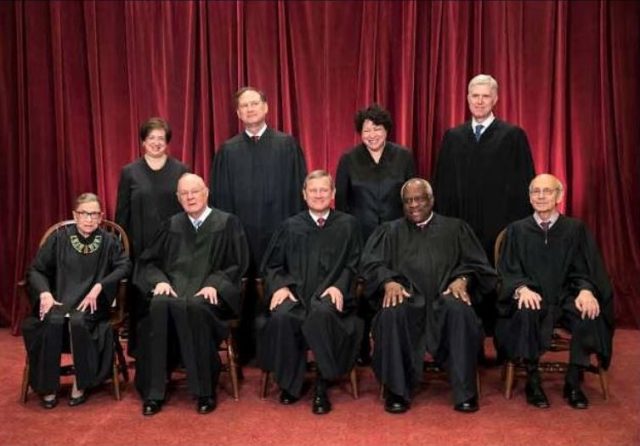Conservative majority scorches Sotomayor’s “scorching” dissent in Ohio voting rolls case

Husted v. A. Philip Randolph Institute presented a fairly boring legal issue of statutory construction.
The legal issue was whether the process used by Ohio to clean up its voter rolls complied with federal statutes.
The problem is significant, as the Supreme Court majority described in the opening paragraph of its Opinion issued today:
It has been estimated that 24 million voter registrations in the United States—about one in eight—are either invalid or significantly inaccurate. Pew Center on the States, Election Initiatives Issue Brief (Feb. 2012). And about 2.75 million people are said to be registered to vote in more than one State. Ibid.At issue in today’s case is an Ohio law that aims to keep the State’s voting lists up to date by removing the names of those who have moved out of the district where they are registered. Ohio uses the failure to vote for two years as a rough way of identifying voters who may have moved, and it then sends a preaddressed, postage prepaid card to these individuals asking them to verify that they still reside at the same address. Voters who do not return this card and fail to vote in any election for four more years are presumed to have moved and are removed from the rolls. We are asked to decide whether this program complies with federal law.
Justice Alito, joined by Kennedy, Roberts, Gorsuch and Thomas, found that the Ohio process complied with the law. The alleged legal violation, that Ohio relied on mere non-voting to strike someone from the voter rolls, was not consistent with the facts. Ohio used a process, allowed by the statute, of sending a card to people who have not voted for two years asking them to confirm whether they have moved. If the card is not returned, the person would not be removed unless the person did not vote in the subsequent two federal election cycles. So it would take a total of 6 years not voting PLUS failure to return the card to be removed.
Justice Breyer wrote a dissent disagreeing with the statutory construction of the majority.
But it was Justice Sotomayor’s dissent which evoked the particular ire of the majority, who saw it as a policy disagreement with Congress:
JUSTICE SOTOMAYOR’s dissent says nothing about what is relevant in this case—namely, the language of the NVRA—but instead accuses us of “ignor[ing] the history of voter suppression” in this country and of “uphold[ing] a program that appears to further the . . . disenfranchisement of minority and low-income voters.” Post, at 5. Those charges are misconceived.The NVRA prohibits state programs that are discriminatory, see §20507(b)(1), but respondents did not assert a claim under that provision. And JUSTICE SOTOMAYOR has not pointed to any evidence in the record that Ohio instituted or has carried out its program with discriminatory intent.* * *The dissents have a policy disagreement, not just with Ohio, but with Congress. But this case presents a question of statutory interpretation, not a question of policy. We have no authority to second-guess Congress or to decide whether Ohio’s Supplemental Process is the ideal method for keeping its voting rolls up to date. The only question before us is whether it violates federal law. It does not.The judgment of the Sixth Circuit is reversed.
And sure enough, Sotomayor’s dissent (starting at page 54 of the pdf.) read like a political manifesto:
… Congress enacted the NVRA against the backdrop of substantial efforts by States to disenfranchise low-income and minority voters, including programs that purged eligible voters from registration lists because they failed to vote in prior elections. The Court errs in ignoring this history and distorting the statutory text to arrive at a conclusion that not only is contrary to the plain language of the NVRA but also contradicts the essential purposes of the statute, ultimately sanctioning the very purging that Congress expressly sought to protect against.Concerted state efforts to prevent minorities from voting and to undermine the efficacy of their votes are an unfortunate feature of our country’s history….In concluding that the Supplemental Process does not violate the NVRA, the majority does more than just misconstrue the statutory text. It entirely ignores the history of voter suppression against which the NVRA was enacted and upholds a program that appears to further the very disenfranchisement of minority and low-income voters that Congress set out to eradicate. States, though, need not choose to be so unwise. Our democracy rests on the ability of all individuals, regardless of race, income, or status, to exercise their right to vote. The majority of States have found ways to maintain accurate voter rolls without initiating removal processes based solely on an individual’s failure to vote. See App. to Brief for League of Women Voters of the United States et al. as Amici Curiae 1a–9a; Brief for State of New York et al. as Amici Curiae 22–28. Communities that are disproportionately affected by unnecessarily harsh registration laws should not tolerate efforts to marginalize their influence in the political process, nor should allies who recognize blatant unfairness stand idly by. Today’s decision forces these communities and their allies to be even more proactive and vigilant in holding their States accountable and working to dismantle the obstacles they face in exercising the fundamental right to vote.
Sotomayor’s dissent was described by a legal analyst for TPM as “scorching“.
Personally, I love Sotomayor’s scorching dissents. I wish her a long career in dissent, scorching or otherwise.
CLICK HERE FOR FULL VERSION OF THIS STORY